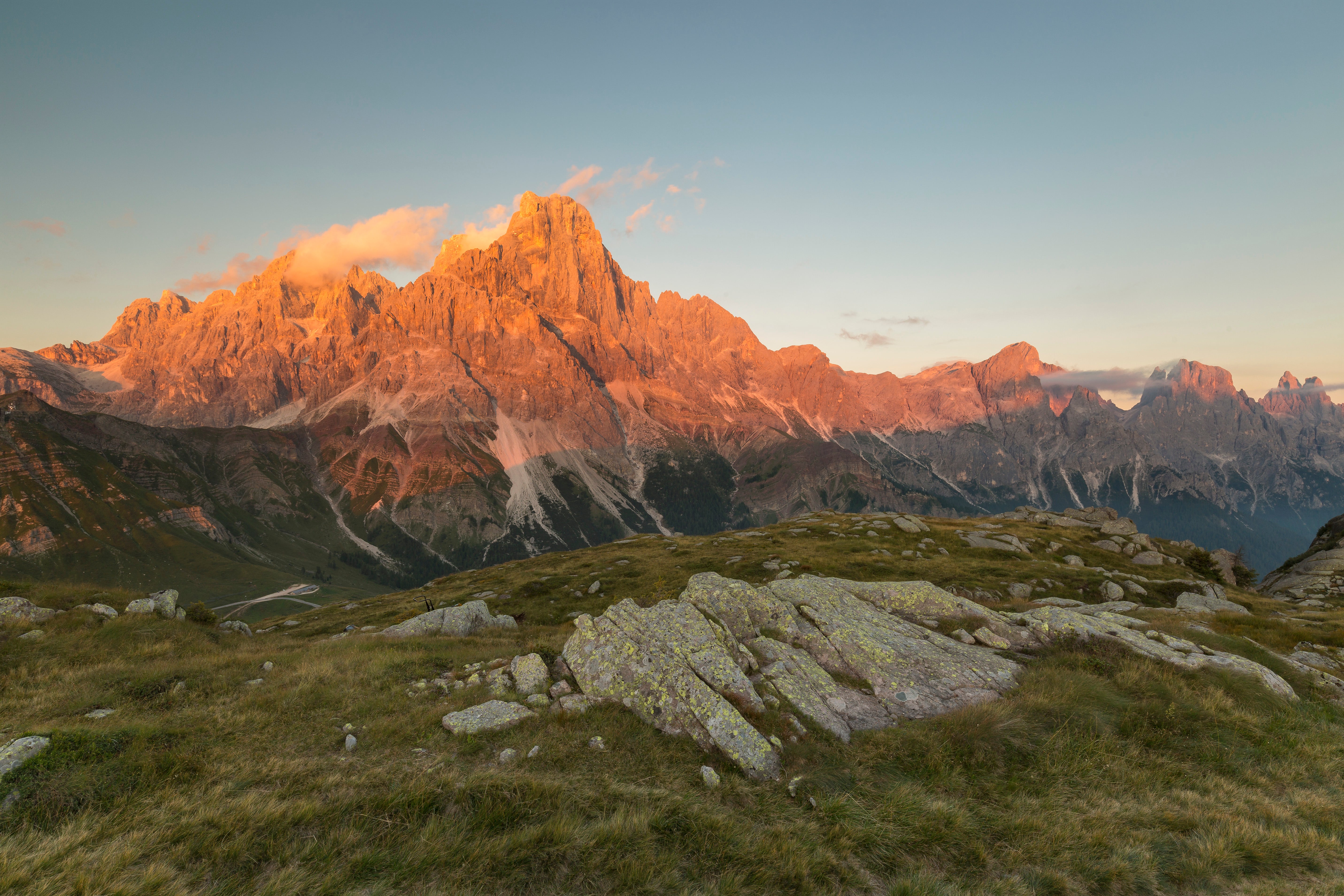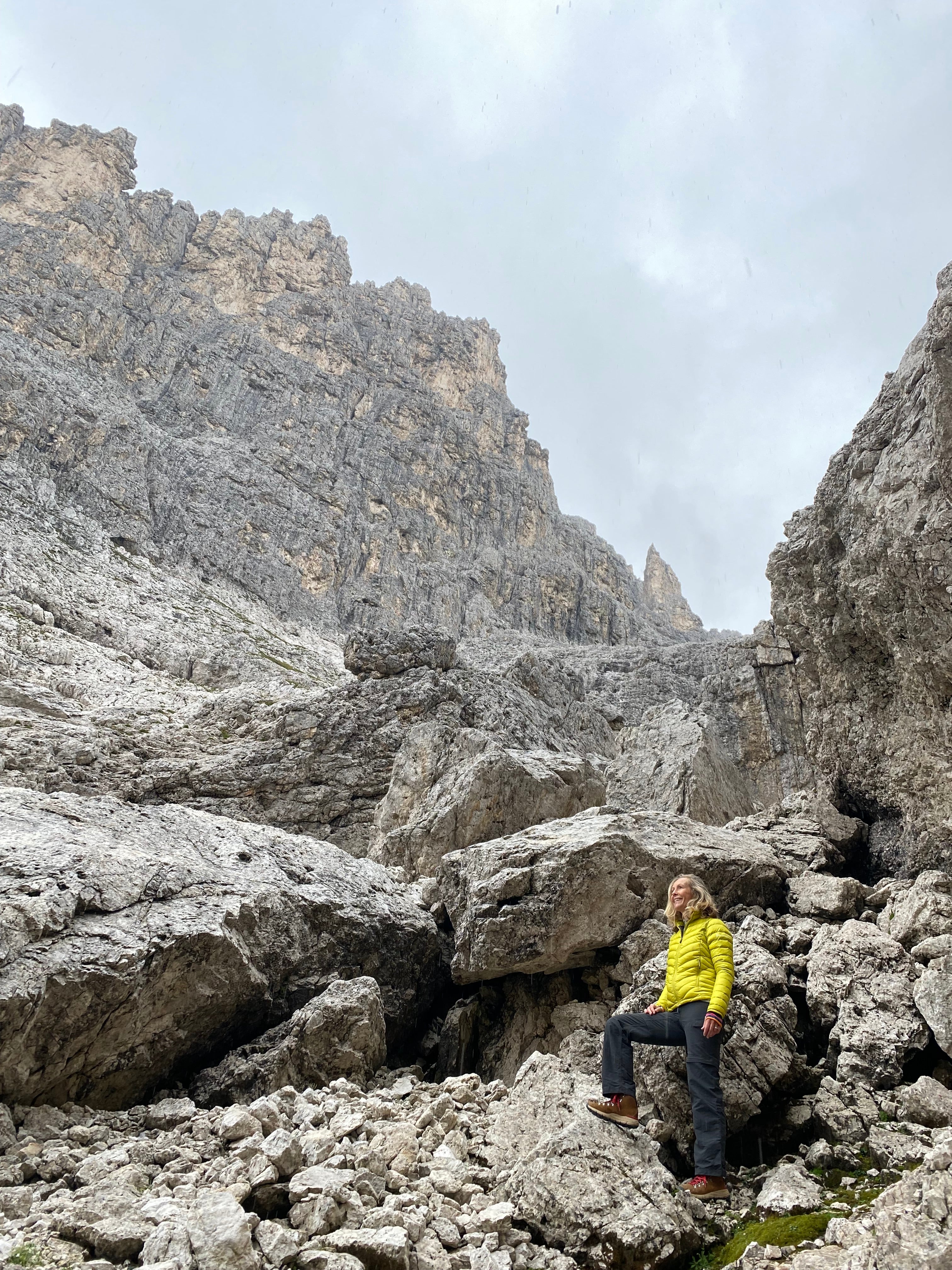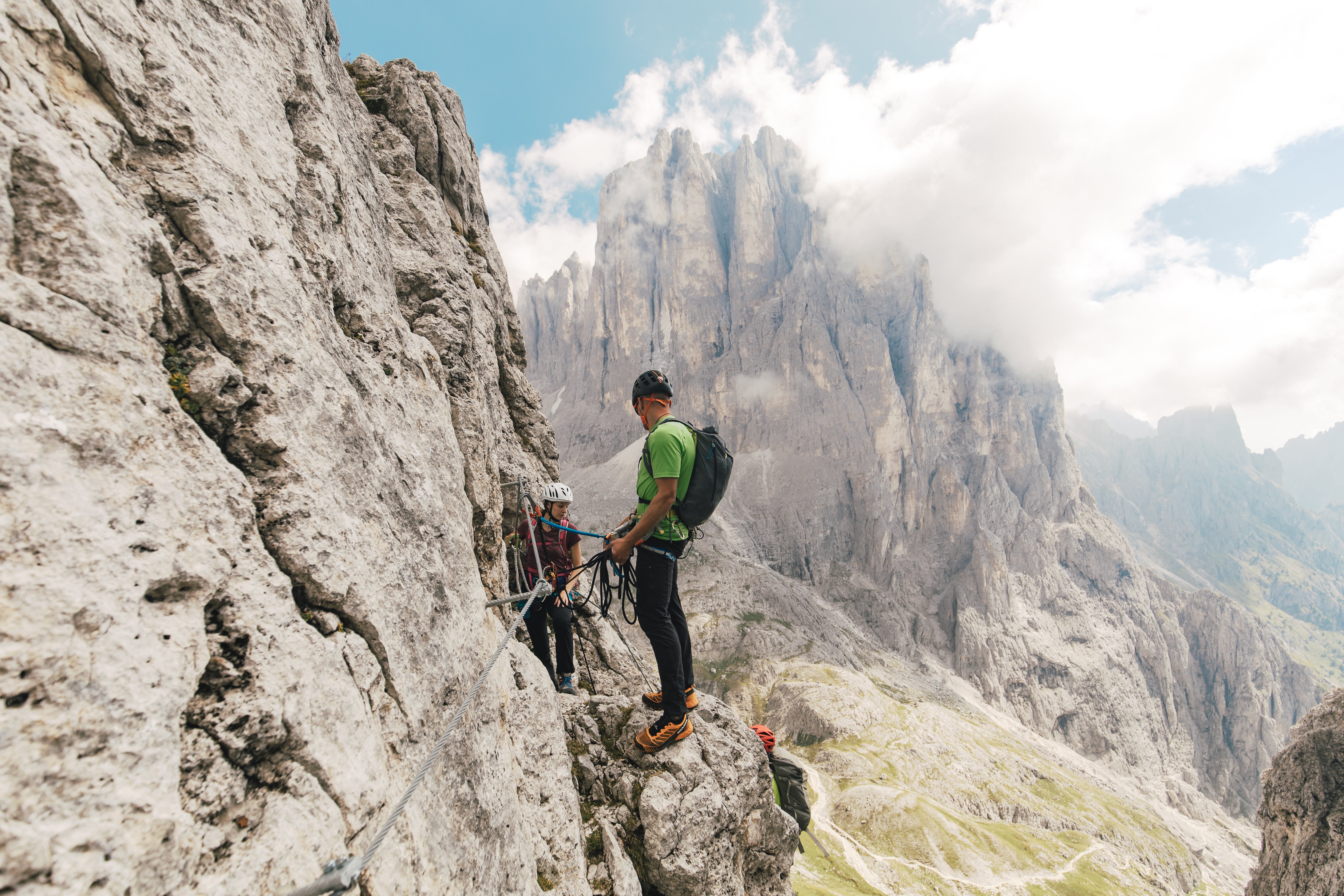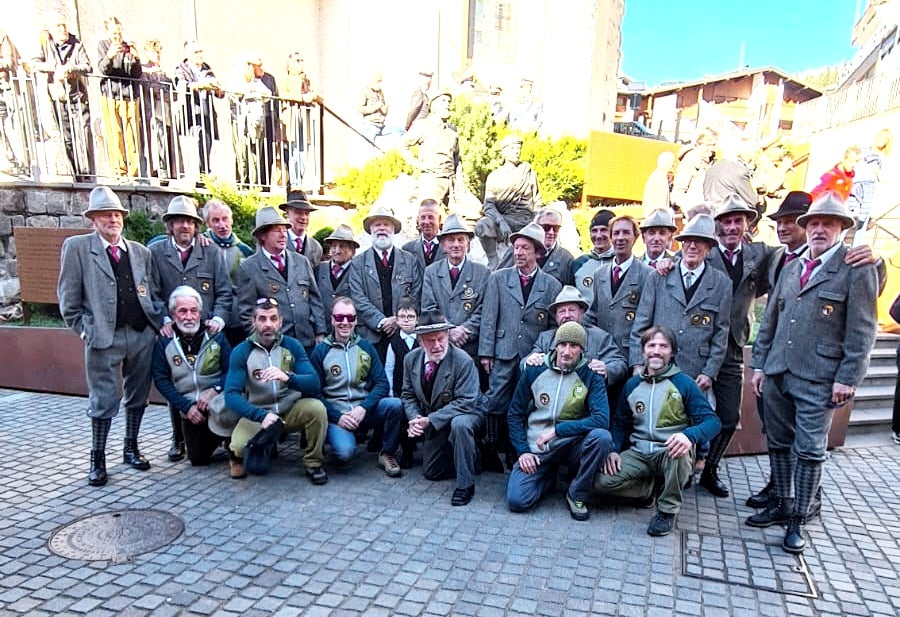The Independent's journalism is supported by our readers. When you purchase through links on our site, we may earn commission.
Uncovering a family legend in the Dolomites – in the footsteps of an 1890s female alpinist
The mountain peak Cima Immink was first scaled by her father-in-law’s great-great-grand aunt and Gabriella Le Breton vowed one day to see it for herself – on travelling to the Pale di San Martino massif, she discovers the legacy of a remarkable, if controversial, woman

“I always imagined I would see it for myself…” My father-in-law’s voice tailed off and his cancer-gnarled fingers tightened their grip on mine as tears engulfed us both. Spring sunshine streamed into the bedroom, a stark reminder of new life unfurling as his life ebbed away. “I will go there,” I vowed to him. “And I’ll tell you all about it when I return.” A promise I knew I could not keep.
I met my father-in-law, Gulliver Immink, at a wedding, on the same day that I met his son. Of Dutch descent like me, he was delighted to see the romance blossoming, aided no doubt by his discrete deliveries of bottles of Champagne to the love birds. His cancer diagnosis came a little over a year later, shortly before our wedding.
On my first visit to Gulliver’s home, I was struck by a photograph of a mountain peak bearing the name Cima Immink. Ever the raconteur, Gulliver regaled me with tales of the peak in the Dolomites that was first scaled in 1891 by the indomitable Jeanne Immink, his great-great-grand aunt. An extraordinary, and controversial woman, Jeannette Friederike Hermine Immink (née Diest) was a pioneering alpinist. The first woman to climb in trousers rather than skirts, Jeanne enjoyed a brief yet action-packed mountaineering career in the 1890s, during which she scaled some of Europe’s most challenging peaks and routes, was credited with several first ascents, and invented the climbing harness.
.jpg)
Gulliver and I often plotted to visit Cima Immink, and the nearby peak of Campanile Giovanna, also named in honour of Jeanne, together. However, “time and tide wait for no man”. And, so it was, that I found myself paying my respects to both Jeanne and Gulliver at the foot of Cima Immink that summer.
The imposing peak is part of the Pale di San Martino, the largest massif in the Dolomites. Submerged beneath a shallow sea 300 million years ago, these mighty coral reefs were thrust up by tectonic forces and whittled into dramatic spires by the elements. Ringed by these pinnacles is the Altipiano delle Pale plateau, a former seabed that now lies exposed 2,700m above sea level, and 1,200m above the town of San Martino di Castrozza. In the words of the intrepid traveller and writer Amelia Edwards in 1872: “I doubt if a more lonely, desolate or tremendous scene is to be found this side of the Andes.”
It took the 38-year-old Jeanne Immink ten hours to climb from San Martino to the peak of Cima Immink (2,862m) – an elevation difference of 1,375m – and back. That included a pause in each direction to duck behind some Arolla stone pine trees to exchange her tweed skirt for “revolutionary” knickerbockers, as the latter weren’t regarded as suitable attire for ladies. Lacking the fitness to retrace Jeanne’s steps (her nickname was La Donna Instancabile or “The Tireless Woman”), I travelled up to the Altipiano by gondola and cable car, chatting with my venerable mountain guide and artist Narci Simion as the views of San Martino di Castrozza opened up below us.

Thanks to its location between the Po Valley and Tyrol, the lush Alpe di Castrozza valley and Passo Rolle mountain pass above it has long been a strategic crossing point for merchants and armies. The Habsburgs paved the Rolle pass (1863-1874), transforming San Martino di Castrozza into a wealthy, thriving destination. Large Victorian hotels emerged, accustomed to hosting members of the Habsburg monarchy, European politicians, artists and literati as well as seasoned climbers and travellers.
During the First World War, the town was occupied by Austrian troops who fixed their defensive line on the Lagorai peak by the Rolle Pass. When that line fell in 1915, the retreating troops burned San Martino to the ground, leaving just one lonely bell tower standing. Rebuilt under Mussolini to rival Cortina d’Ampezzo, the flourishing village was then annexed by German troops in 1943 before becoming part of the autonomous region of Trentino-South Tyrol in 1946.
Throughout this tumultuous history, a handful of families have remained loyal to San Martino, dedicated to building – and rebuilding – their hotels and climbing the peaks that tower above it. The hoteliers include the Toffol, Panzer and Langes families, while climbing dynasties include the Zagonels, Bottegas and Zecchinis. These families remain active in the town today, which is intrinsically linked to alpinism to an extent I have never encountered elsewhere.

As I crossed the Altipiano with Narci Simion, he recounted stories of early visitors to San Martino and the Aquile di San Martino (San Martino Eagles) guiding company, of which he was president for many years. Established in 1881, the original Aquile guides were local shepherds and hunters, who honed their climbing skills to become revered for their bravery and intimate knowledge of the Dolomites. We made our way to the Rifugio Rosetta, a stone hut perched on an outcrop in the eery lunar plateau, its cheery white and blue painted shutters providing welcome relief from the monochrome landscape.
Jeanne Immink stayed in the original rifugio (also burned down in 1915) in August 1891 before summiting one of her first peaks in the area, the Pala di San Martino. Scanning the walls of the atmospheric hut, papered with images of climbers of bygone eras, I found a photo of Jeanne. Taken by the pioneering German climber and mountain photographer Theodor Wundt while climbing the sheer face of Cima Piccolo, the image graced the front cover of his book about Dolomite climbs, Wanderungen in den Ampezzaner Dolomiten (Berlin, 1894). The image of a woman mountain climbing - in trousers - generated almost equal shock, consternation, outrage and admiration.
The owner of the Rosetta, the accomplished climber and mountain guide Mariano Lott, welcomed Narci with the warm embrace of trusted friends. But when Narci presented me – “May I introduce you to a descendant of Jeanne Immink” – I was grasped by both hands in amazement and virtually bowed to. As I learned over the following days, neither Narci nor Jeanne require introduction here, both are local legends.

Most hikers following the narrow trail leading from Rifugio Rosetta over the Passo di Ball to Rifugio Pradidali won’t realise they’re passing Cima Immink. The muscular peak forms part of a series of summits in a stupendous landscape best appreciated as part of the Palaronda trek, a four-day hut-to-hut hiking tour. Covering some 22 miles and 9,800 vertical feet, this circular route requires a good level of fitness, a head for heights and, ideally, experience of hiking at altitude. In return, you’ll enjoy blissful immersion in the unparalleled beauty of the Pale di San Martino, experiencing its scale and majesty as the setting sun blushes the limestone spires pink, apricot and lilac. Evenings spent in the Rosetta and Pradidali huts are convivial affairs, feasting on simple local fare in the company of thermal-clad outdoorsy types.
Whether you complete the Palaronda, tackle one of the challenging via ferrata routes that criss-cross the Pale or simply ride up the cable car for lunch at the Rifugio Rosetta, it is essential to toast your alpinism with a drink at La Mia Enoteca back down in San Martino. Soft jazz plays, candles flicker, and the walls and timber beams of the wine bar are plastered with photographs of generations of local climbers and Aquile mountain guides, including Renzo Debortolis, the wine bar’s founder. Debortolis’ son, Matteo, serves glasses of crisp Trentino white wine, shearing off melt-in-the-mouth slithers of ham with his flywheel slicer to accompany them.

I met Narci here after our hike, poring over his private collection of antique Dolomites climbing guides and some of his coveted paintings of them. Impervious to the late summer chill, leathery-skinned mountain men sat on the small patio, discussing the prestigious Piolets d’Or (golden ice axes) awards being hosted in town, the Oscars of mountaineering. To my delight, Narci deemed me capable of summiting Cima Immink, confirming my next Dolomites adventure.
I learned many things from my father-in-law but his last words to me ring loudest in my ears. “Please come back soon. I don’t think I have much longer.” Don’t put off your dreams, they won’t wait for you.
Getting there
Fly from London to Bolzano with SkyAlps (from €190 one-way, including in-flight South Tyrolean wines and snacks), which is 1 hour 40 minutes drive from San Martino di Castrozza.
Stay in the charming two-bedroom Jeanne Immink apartment at Langes Residences, open June through September in summer.
For more information about San Martino di Castrozza visit sanmartino.com. Visit palarondatrek.com for details about hiking and via ferrata in the Pala San Martino. German and Dutch speakers can learn more about Jeanne Immink in the book Die Frau, die in die Wolken stieg by Harry Muré.






Join our commenting forum
Join thought-provoking conversations, follow other Independent readers and see their replies
Comments